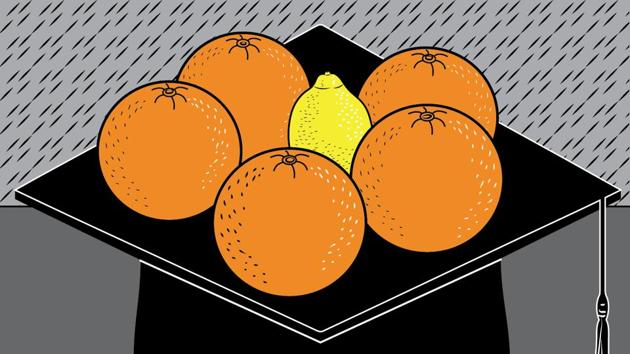How not to promote institutions of excellence
Social media is abuzz with theories as to why Jio Institute was chosen ahead of other applicants. I do not wish to add to this speculation. But I do want to say again, and emphatically, that this is an altogether puzzling choice.
Consider this hypothetical situation. A wealthy individual wishes to invest in a company making petroleum products. He has two choices; to put his money in a firm promoted by Reliance, or to put it instead in a firm promoted by a group of academics headed by Professor Raghuram Rajan of the University of Chicago. The choice is, as it were, a no-brainer; a smart investor would choose Reliance over Rajan, every time.

Now consider this actual situation. The government of India wishes to identify academic institutions that could potentially become world-class, and free them from the red tape of babus in New Delhi. The choice is between a university promoted by Reliance, and another mentored by Professor Raghuram Rajan of the University of Chicago. And, would you believe it, our government actually chooses the former.
Before scrutinising this choice further, let me sketch in the larger context. Last year, the government announced a competition to choose 20 universities of excellence, 10 public, 10 private. Applications were called for, which came pouring in from all across the country. A shortlist was prepared, and representatives of some 40 universities were called to make presentations before a jury headed by a former IAS officer.
These interviews were held in early April. Those excluded complained of being left out, so the jury interviewed them too. Several months passed, but no decision was communicated to the applicants or to the public. Last week, out of the blue, the government released a list of selected institutions, these numbering a mere six, instead of 20 as originally proposed.
Three of the chosen names are in the public sector. These are the Indian Institute of Science, and IIT-Delhi and IIT-Mumbai respectively. Of the three private institutions, two are of long standing, the Birla Institute of Technology and Science, and the Manipal Academy of Higher Education.
This writer knows these five institutions well. I have lectured in all, and have professional colleagues in each. All are respectable and credible. That said, a case can be made for IIT-Madras instead of IIT-Delhi, and for including an institution that has a track record in the humanities as well as in the sciences, such as Hyderabad Central University. Besides, while both BITS and MAHE have produced thousands of excellent students, they are essentially teaching institutions. Their research output has never remotely approached global standards, and it is unlikely that it ever will.
Among the other private universities shortlisted by the jury are those named after Ashoka, Jindal, Azim Premji and Ahmedabad. I have had professional interactions with these institutions too. They have different strengths; Jindal has the best infrastructure, Ashoka the best social science departments, Azim Premji University does research most relevant to policy issues, while Ahmedabad University has an innovatively trans-disciplinary approach to higher education. If the jury had focused more on future research potential rather than past teaching record, two among these four may have been chosen instead of BITS and MAHE.
By far the most problematic choice, however, was the sixth, of the yet-to-be-established Jio Institute. The choice was controversial because of the lack of prior expertise of the promoter, and in larger part because unlike Ashoka, Jindal, APU, etc, this new university is at present merely an idea. It has no buildings, no faculty, and no students at all.
When the name of Jio Institute was found on the list of six, it elicited immediate criticism on social media. In response, the ministry of human resource development issued a clarification saying the jury had been asked to consider ‘greenfield projects’ as well. In that case, why Jio Institute and why not some other as yet unrealised idea? Why, for example, had the jury not selected the new KREA University, which is in a more advanced stage of preparation? With a campus rapidly being developed outside Chennai, KREA has a governing council which includes Anand Mahindra, Kiran Mazumdar-Shaw, Anu Aga and N. Vaghul. KREA’s Academic Council is chaired by Raghuram Rajan; its other members include the gifted historian Srinath Raghavan, the brilliant classical musician TM Krishna, and the great mathematician Manjul Bhargava.
My own view, as a close student of, and continuous participant in, academic life in India for more than four decades now, is that two among Ashoka, Azim Premji and Ahmedabad universities should have made this select list of six, because they have already, as it were, demonstrated proof of concept. They are up and running, have attracted outstanding full-time faculty from across India and the world, and begun teaching programmes. They certainly have the potential to become world-class. Perhaps a more qualified and independent-minded jury would have placed faith in them.
Even if, for argument’s sake, the jury decided to favour one so-called ‘greenfield project’, why Jio Institute over the other contenders? Were the more impressive credentials of KREA considered and carefully scrutinised?
As I write this column, social media is abuzz with theories as to why Jio Institute was chosen ahead of other applicants. I do not wish to add to this speculation. But I do want to say again, and emphatically, that this is an altogether puzzling choice.
There was at least one other ‘greenfield project’ that seemed more credible, as well as several private universities, already in existence, that have shown their worth in a short period of time, and would have been further motivated to achieve excellence by the official recognition that this ‘Institutions of Eminence’ label seeks to provide.
Ramachandra Guha’s books include Gandhi Before India
The views expressed are personal






